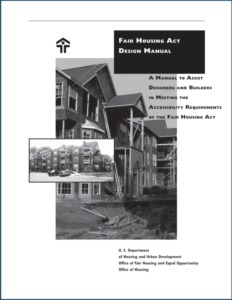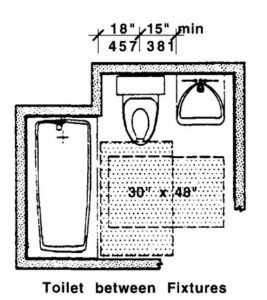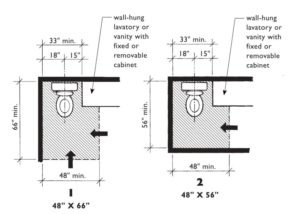- April 24, 2022
- 2 Comments
- In Accessible Design and Construction
- By Peter Stratton
This blog post was originally published on March 23, 2020. It was updated on April 24, 2022 to provide the latest, most accurate information on HUD-approved safe harbors for FHA compliance.
 Compliance with the accessible design and construction requirements of the Fair Housing Act (FHA), a federal civil rights law, has significantly improved since the early 1990s when the regulations were promulgated. Unfortunately, a quick search of recent news articles will reveal that noncompliance with basic FHA requirements continues to be a problem in newly constructed multifamily projects nationwide. Owners, developers, architects, and others are still cited for noncompliance with the FHA’s seven design and construction requirements even though it has been more than 30 years since those requirements went into effect.
Compliance with the accessible design and construction requirements of the Fair Housing Act (FHA), a federal civil rights law, has significantly improved since the early 1990s when the regulations were promulgated. Unfortunately, a quick search of recent news articles will reveal that noncompliance with basic FHA requirements continues to be a problem in newly constructed multifamily projects nationwide. Owners, developers, architects, and others are still cited for noncompliance with the FHA’s seven design and construction requirements even though it has been more than 30 years since those requirements went into effect.
Based on our experience, one of the contributing factors in continued noncompliance is the common misconception that following the accessibility requirements of a building code will result in compliance with the FHA. It is important to note that if the accessibility requirements of one of the HUD-approved safe harbors are not incorporated into the design of a multifamily development, and the project complies only with the accessibility requirements of a building code, the risk of noncompliance exists.
Throughout the 1990s and early 2000s, many building codes fell far short of FHA compliance. For example, many developers in New York City relied on compliance with NYC’s Local Law 58 of 1987, believing that they would also be compliant with the Fair Housing Act. Unfortunately, this resulted in widespread noncompliance. LL58 permitted step up terraces and small bathroom layouts with in-swinging doors, among other design elements that did not satisfy FHA compliance. The problem has certainly become less pervasive in more recent years as the ICC and local jurisdictions have become aware of shortcomings in their code requirements, but there are still some FHA criteria that have fallen through the cracks in even the most up-to-date building codes.
To ensure compliance with the accessible design and construction requirements of the FHA and the local code, be sure to comply with both. To avoid the risk of noncompliance, SWA recommends selecting one of the HUD-approved ‘safe harbors’ and applying it to the entire project. When weighing the requirements of the local code against those of the FHA, follow the most stringent criteria. By implementing this best practice, industry professionals will achieve compliance with the FHA regulations.
What Are the HUD-Approved Safe Harbors?
Before March 8, 2021, there were ten HUD-approved safe harbors for FHA compliance:
- HUD Fair Housing Act Accessibility Guidelines published on March 6, 1991 and the Supplemental Notice to Fair Housing Accessibility Guidelines: Questions and Answers about the Guidelines, published on June 28, 1994;
- HUD Fair Housing Act Design Manual;
- ANSI A117.1 (1986), used with the Fair Housing Act, HUD’s regulations, and the Guidelines;
- CABO/ANSI A117.1 (1992), used with the Fair Housing Act, HUD’s regulations, and the Guidelines;
- ICC/ANSI A117.1 (1998), used with the Fair Housing Act, HUD’s regulations, and the Guidelines;
- Code Requirements for Housing Accessibility 2000 (CRHA);
- International Building Code 2000 as amended by the 2001 Supplement to the International Codes;
- International Building Code 2003, on the condition that the ICC publish and distribute a statement that indicates that “the ICC interprets Section 1104.1, and specifically the exception to Section1104.1, to be read together with Section 1107.4, and that the Code requires an accessible pedestrian route from site arrival points to accessible building entrances, unless site impracticality applies. Exception 1 to Section 1107.4 is not applicable to site arrival points for any Type B dwelling units because site impracticality is addressed under Section 1107.7”
- ICC/ANSI A117.1 (2003), used with the Fair Housing Act, HUD’s regulations, and the Guidelines; and,
- The 2006 International Building Code (loose leaf format only)
And, as of March 8, 2021, the following safe harbors have also been approved:
- ICC A117.1-2009
- The 2009 International Building Code
- The 2012 International Building Code
- The 2015 International Building Code
- The 2018 International Building Code
The final rule published in the December 8, 2020 edition of the Federal Register states that HUD has reviewed the updated editions of the IBC and found that it “found that the accessibility provision of these IBC editions [2009, 2012, 2015, and 2018] are consistent with the requirements in the Act, HUD’s regulations, and the Guidelines.” And, that it “…did not find any provision that it believes provides less accessibility than what is required in the Act, the regulations, and the Guidelines.”
This is great news for any project teams located in jurisdictions that adopt Chapter 11 of an approved edition of the IBC without exception as it eliminates a lot of the confusion caused by contradictory requirements between FHA and building code criteria.
What if my project is not in a jurisdiction that adopts Chapter 11 of the IBC?
For project teams in jurisdictions that do not adopt Chapter 11 of the IBC or adopt it with exceptions, the chosen safe harbor for FHA compliance must still be thought through carefully.
For example, in Massachusetts, 521 CMR Section 42.5 requires a 30×48 inch clear floor space positioned for a parallel or forward approach to a water closet in Group 1 dwelling unit bathrooms (see image on left, below). No minimum dimension exists for the distance between the water closet rear wall and an opposing wall or fixture.
Unless a HUD-approved FHA safe harbor is also applied to the project, a noncompliant clearance at the water closet may be provided. The Fair Housing Act Design Manual, the safe harbor we most recommend for projects in Massachusetts, requires a minimum clearance of 56” perpendicular to the water closet rear wall for a side approach to the fixture and 66” for a front approach (see image on right, below).

521 CMR Figure 42c Toilet Locations

FHADM Page 7.43 Clear Floor Space at Toilets
We are still working with designers to determine which safe harbor makes the most sense for a given project. Please stay tuned for updates and insights from our consultants. In the meantime, before you embark on your next project, don’t forget to ask yourself, “What is my safe harbor?”
Written by:

Theresa D’Andrea, Senior Accessibility Consultant

Peter A. Stratton, Senior Vice President, Managing Director, Accessibility Services

I thought if you had one spec b in a dwelling with more than one bathroom you don’t need spec a and those bathrooms don’t need clear floor spaces. from 1991 guidelines
Dear Theresa and Peter.
Thank you so much for your interesting article which I find very helpful as an Architect.
I do have one question for you if I may. If ANSI 2003 (and now 2009 as well) is a safe harbor, what does “used with the Fair Housing Act…..” mean?